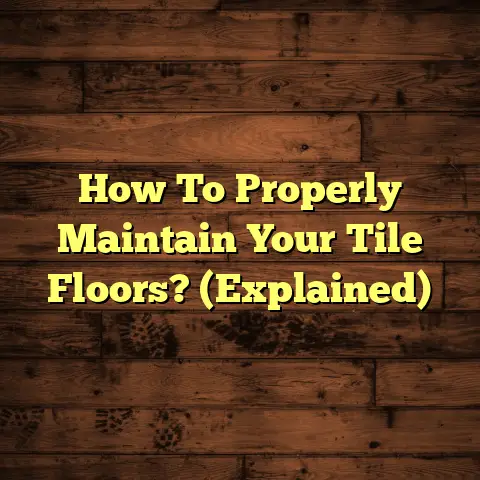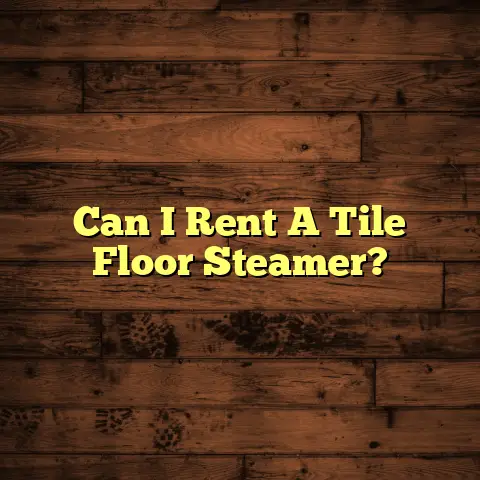Floor Buffer vs Scrubber: Which To Use? (8 Uses)
Hey folks! Ever walked into a gleaming showroom and then into a scruffy warehouse and wondered what’s the secret to keeping floors in tip-top shape? You might think a floor buffer and a floor scrubber are the same thing, just different names.
Well, I’m here to tell you that using the wrong tool can lead to subpar results and potentially damage your floors. Trust me, I’ve seen it all in my years as a flooring contractor.
This article will dive deep into the key differences between floor buffers and scrubbers. We’ll explore their specific uses, advantages, and the scenarios where each shines. So, let’s get started!
Understanding Floor Buffers and Scrubbers
Alright, before we dive into the nitty-gritty, let’s define what we’re talking about. What exactly is a floor buffer, and how does it differ from a floor scrubber?
What is a Floor Buffer?
Think of a floor buffer as a polisher. It’s designed to maintain the shine on hard floors. It’s like giving your floors a spa day!
These machines typically have a rotating pad at the bottom that spins at high speeds. This action buffs the floor, smoothing out minor imperfections and restoring its luster.
Floor buffers are great for floors that are already in pretty good shape, but just need a little pick-me-up.
What is a Floor Scrubber?
Now, a floor scrubber is a workhorse. This machine is all about deep cleaning. It’s designed to remove dirt, grime, and stains that a buffer just can’t handle.
Scrubbers usually dispense water and cleaning solutions onto the floor, while rotating brushes or pads scrub away the dirt. Many scrubbers also have a vacuum system that sucks up the dirty water, leaving the floor clean and dry.
These are your go-to for floors that see a lot of action and need a thorough cleaning.
Key Differences: Operation, Purpose, and Results
So, what are the main differences between these two machines? Here’s a quick rundown:
| Feature | Floor Buffer | Floor Scrubber |
|---|---|---|
| Primary Function | Polishing, maintaining shine | Deep cleaning, removing dirt & grime |
| Operation | Dry buffing with rotating pad | Wet scrubbing with brushes & cleaning solution |
| Results | Restores shine, smooths imperfections | Removes stains, dirt, and bacteria |
| Best For | Already clean floors | Dirty, high-traffic floors |
See the difference? Buffers are for maintaining a clean floor, while scrubbers are for making it clean.
Use Case 1: Routine Maintenance
Let’s talk about routine maintenance. How often should you be using these machines, and for what purpose?
Floor Buffer: Maintaining the Shine
For polished floors, a buffer is your best friend. Think of it as a regular touch-up.
For example, in a retail store with polished concrete floors, a buffer can be used daily or every other day to maintain the shine and keep the floor looking its best.
This is especially important in high-traffic areas where the floor is prone to scuffs and scratches.
I’ve seen businesses that buffer regularly save a ton on professional waxing and polishing services. It’s all about preventative care!
Floor Scrubber: Deep Cleaning for High-Traffic Areas
Now, for areas that see a lot of foot traffic, a scrubber is essential. Think of a school hallway, a hospital corridor, or a busy restaurant kitchen.
These areas need regular deep cleaning to remove dirt, grime, and bacteria. A scrubber can handle this task easily, leaving the floor clean and sanitized.
I recommend scrubbing high-traffic areas at least once a week, or even more frequently if needed.
Use Case 2: Commercial vs. Residential Use
Are these machines just for businesses, or can homeowners use them too? Let’s break it down.
Commercial Settings: Heavy-Duty Cleaning vs. Showroom Appearance
In commercial settings, you’ll often see scrubbers used for heavy-duty cleaning in areas like warehouses, factories, and commercial kitchens.
These areas need to be cleaned thoroughly to maintain hygiene and safety standards.
On the other hand, buffers are often used in showrooms, lobbies, and other areas where appearance is important.
Imagine a car dealership showroom, where the floors need to be spotless and shiny to showcase the vehicles. A buffer is perfect for this task.
Residential Settings: Hardwood and Tile Maintenance
Homeowners can definitely benefit from both buffers and scrubbers.
A buffer is great for maintaining hardwood or tile floors, especially if they have a polished finish. It can help restore the shine and remove minor scuffs and scratches.
I’ve seen homeowners use buffers to keep their hardwood floors looking beautiful for years.
A scrubber can be used in kitchens, bathrooms, and other areas where the floor is prone to dirt and grime. It’s especially useful for cleaning tile and grout lines, which can be difficult to clean by hand.
Use Case 3: Floor Types and Conditions
Not all floors are created equal. Some are better suited for buffering, while others require the deep cleaning power of a scrubber.
Floor Buffer: Varnished Wood and Polished Concrete
Buffers work best on floors that have a smooth, polished surface. Varnished wood, polished concrete, and certain types of tile are all good candidates for buffering.
The key is that the floor needs to be relatively clean to begin with. Buffering a dirty floor will just spread the dirt around and scratch the surface.
Floor Scrubber: Vinyl, Tile, and Grout Lines
Scrubbers are more versatile and can be used on a wider range of floor types. Vinyl, tile, and even some types of concrete can be effectively cleaned with a scrubber.
Scrubbers are also great for cleaning grout lines, which can be a real pain to clean by hand. The brushes on the scrubber can get into the grout lines and remove dirt and grime that would otherwise be difficult to reach.
Use Case 4: Time Efficiency
Time is money, right? So, which machine will save you more time in the long run?
Floor Buffer: Quick Touch-Ups
A buffer can significantly cut down the time spent on maintaining shiny floors. It’s ideal for quick touch-ups and can be used frequently to keep the floor looking its best.
I’ve seen businesses use buffers to quickly polish their floors before opening each day, ensuring that they always look their best.
Floor Scrubber: Thorough Cleaning
Scrubbers may take longer to use than buffers, but they’re essential for a thorough clean. While it takes more time, the deep clean is worth it.
For example, scrubbing a large commercial kitchen can take several hours, but it’s necessary to remove grease, food particles, and other contaminants that can accumulate on the floor.
Use Case 5: Cost-Effectiveness
Let’s talk about the bottom line. Which machine will save you money in the long run?
Floor Buffer: Reduced Need for Professional Services
Using a buffer for routine maintenance can reduce the need for professional waxing and polishing services. This can save you a significant amount of money over time.
Think about it: instead of paying a professional cleaning company to wax your floors every few months, you can simply buffer them yourself on a regular basis.
Floor Scrubber: Savings on Labor and Cleaning Supplies
While the upfront investment in a scrubber may be higher, it can save you money on labor and cleaning supplies in the long run.
A scrubber can clean floors much faster and more effectively than manual cleaning methods, reducing the amount of time and effort required to keep your floors clean.
Additionally, some scrubbers use less water and cleaning solution than traditional mopping methods, which can save you money on supplies.
Use Case 6: Environmental Considerations
In today’s world, it’s important to consider the environmental impact of our cleaning practices. Which machine is more eco-friendly?
Floor Buffer: Reducing Harsh Chemicals
Buffers can be more environmentally friendly by reducing the need for harsh chemicals when maintaining already polished floors.
By simply buffing the floor on a regular basis, you can remove minor dirt and scuffs without having to use strong cleaning solutions.
Floor Scrubber: Eco-Friendly Solutions and Water-Saving Technology
Scrubbers can also be environmentally friendly, especially if they use eco-friendly cleaning solutions and water-saving technology.
Many scrubbers are now equipped with features that reduce water consumption, such as automatic shut-off valves and adjustable water flow settings.
Additionally, there are many eco-friendly cleaning solutions available that are safe for both the environment and your health.
Use Case 7: Health and Safety
Keeping your floors clean isn’t just about aesthetics. It’s also about health and safety.
Floor Buffer: Reducing Slip Hazards
Maintaining floors with a buffer can reduce slip hazards by keeping surfaces clean and polished.
A polished floor is less likely to accumulate dirt and grime, which can make the surface slippery. Additionally, a buffer can smooth out minor imperfections that could cause someone to trip.
Floor Scrubber: Removing Harmful Bacteria and Allergens
Scrubbers can remove harmful bacteria and allergens, improving overall indoor air quality.
By deep cleaning the floor, a scrubber can remove contaminants that can trigger allergies and respiratory problems. This is especially important in areas where people spend a lot of time, such as schools, hospitals, and offices.
Use Case 8: Versatility
Finally, let’s talk about versatility. Which machine can handle a wider range of tasks?
Floor Buffer: Attachments and Pads for Different Finishes
Buffers are versatile in terms of attachments and pads for different finishes.
You can use different types of pads to achieve different levels of shine, from a matte finish to a high-gloss finish. You can also use different attachments to clean baseboards, stairs, and other hard-to-reach areas.
Floor Scrubber: Adaptability for Various Cleaning Solutions
Scrubbers are adaptable for various cleaning solutions and floor types.
You can use different types of cleaning solutions to tackle different types of dirt and grime. You can also adjust the brush pressure and water flow to suit different floor types.
Conclusion
So, there you have it! Floor buffers and scrubbers are two different tools with distinct functions.
Choosing the right tool depends on your specific cleaning needs, floor types, and maintenance goals.
Remember, a buffer is great for maintaining the shine on already clean floors, while a scrubber is essential for deep cleaning dirty floors.
By understanding the differences between these two machines, you can make informed decisions that will keep your floors clean, safe, and visually appealing for years to come.
Now go forth and conquer those floors!





